Fall-blooming Camellias Part 3
Carolyn’s Shade Gardens is a retail nursery located in Bryn Mawr, PA, specializing in showy, colorful, and unusual plants for shade. The only plants that we ship are snowdrops within the US. For catalogues and announcements of local events, please send your full name, mailing address, and cell number to carolyn@carolynsshadegardens.com and indicate whether you are interested in snowdrops, hellebores, and/or hostas. Click here to get to the home page of our website for catalogues and information about our nursery and to subscribe to our blog.
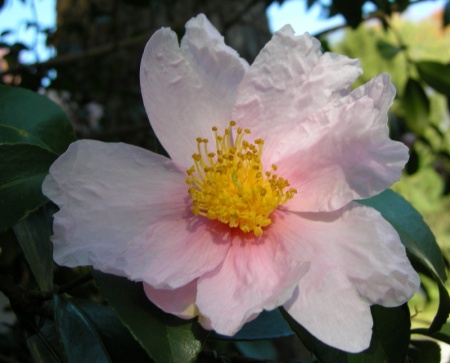 Unnamed camellia developed by William Ackerman who has hybridized many wonderful fall-blooming camellias for the U.S. National Arboretum. For an article about his camellia introductions, click here.
Unnamed camellia developed by William Ackerman who has hybridized many wonderful fall-blooming camellias for the U.S. National Arboretum. For an article about his camellia introductions, click here.
Last December I wrote two popular articles about fall-blooming camellias. Fall-blooming Camellias Part 1 explains that these camellias are fully hardy and easy to grow in the mid-Atlantic U.S. and shows photos of my plants. It also has links to more information. Part 2 covered my visit to the gardens of camellia expert Charles Cresson in Swarthmore, Pennsylvania, whose camellia collection includes over 60 specimens. This week I visited Charles’s gardens again, about a month earlier than last time, to view and photograph more camellias (I am an addict now). In this article, I want to share that visit with you. On Garden Blogger’s Bloom Day, I will show photos of my own plants in bloom.
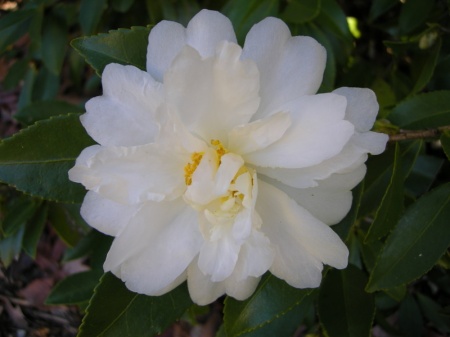 Camellia x ‘Snow Flurry’ is one of the earliest flowering fall-bloomers of the Ackerman hybrids with an arching habit and anemone to peony form flowers.
Camellia x ‘Snow Flurry’ is one of the earliest flowering fall-bloomers of the Ackerman hybrids with an arching habit and anemone to peony form flowers.
During my time in Charles’s garden, I revisited some of my favorite camellias pictured in my post last December, including ‘Snow Flurry’ above and the cranberry-flowered camellia and ‘Winter’s Snowman’ pictured below.
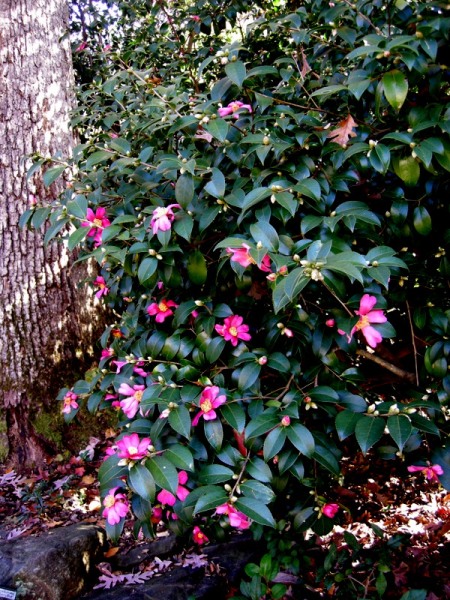 Cranberry-flowered camellia (not introduced for sale): fall-blooming camellias are loaded with buds right now and will continue to bloom over the next two months, depending on the weather. Even if the open flowers are frozen during a cold spell, the remaining buds will open when the weather warms.
Cranberry-flowered camellia (not introduced for sale): fall-blooming camellias are loaded with buds right now and will continue to bloom over the next two months, depending on the weather. Even if the open flowers are frozen during a cold spell, the remaining buds will open when the weather warms.
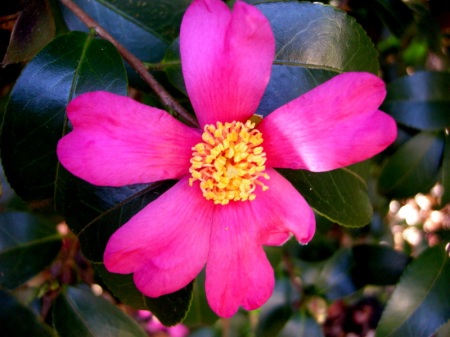 A close up of the cranberry-flowered camellia pictured above (not introduced)
A close up of the cranberry-flowered camellia pictured above (not introduced)
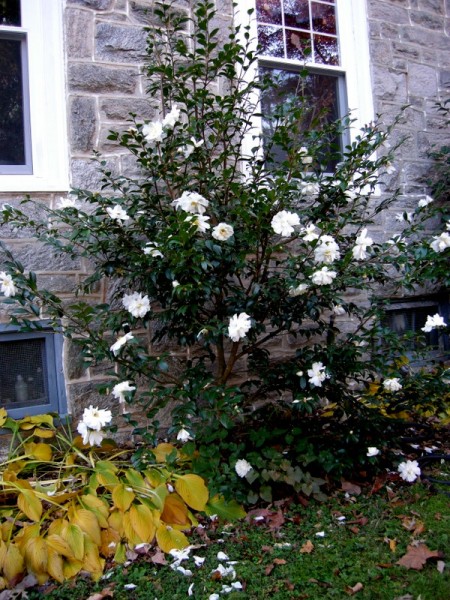 The large, semi-double flowers of the Ackerman hybrid Camellia x ‘Winter’s Snowman’ really stand out in November and December. ‘Winter’s Snowman’ has an upright, narrow habit.
The large, semi-double flowers of the Ackerman hybrid Camellia x ‘Winter’s Snowman’ really stand out in November and December. ‘Winter’s Snowman’ has an upright, narrow habit.
 Camellia x ‘Winter’s Snowman’: If you look at my post from last December, you will see that ‘Winter’s Snowman’ can have both the semi-double flower pictured there and the anemone form flower above. Both are gorgeous.
Camellia x ‘Winter’s Snowman’: If you look at my post from last December, you will see that ‘Winter’s Snowman’ can have both the semi-double flower pictured there and the anemone form flower above. Both are gorgeous.
Because I visited earlier in the season this year, I was able to photograph seven additional camellias:
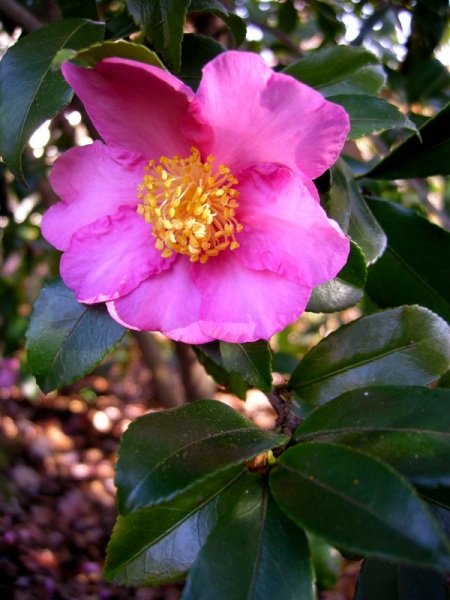 Camellia x ‘Winter’s Star’ is an October and November blooming Ackerman hybrid with single flowers and an upright form.
Camellia x ‘Winter’s Star’ is an October and November blooming Ackerman hybrid with single flowers and an upright form.
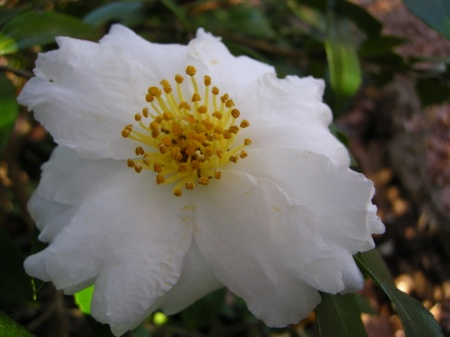 This is a lovely semi-double white camellia hybridized by Charles but not introduced for sale or named.
This is a lovely semi-double white camellia hybridized by Charles but not introduced for sale or named.
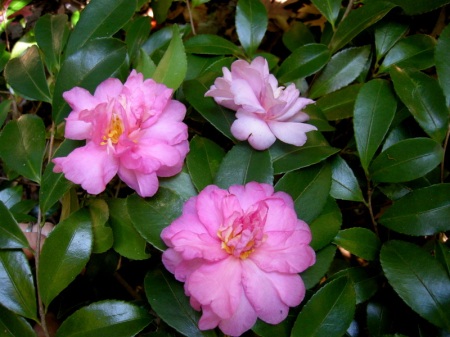 Camellia x ‘Winter’s Interlude’ is a November and December blooming Ackerman hybrid with anemone form flowers and an upright spreading habit.
Camellia x ‘Winter’s Interlude’ is a November and December blooming Ackerman hybrid with anemone form flowers and an upright spreading habit.
 This camellia, which Charles grew from cuttings given to him by North Carolina State University, is very beautiful, but has not been introduced for sale.
This camellia, which Charles grew from cuttings given to him by North Carolina State University, is very beautiful, but has not been introduced for sale.
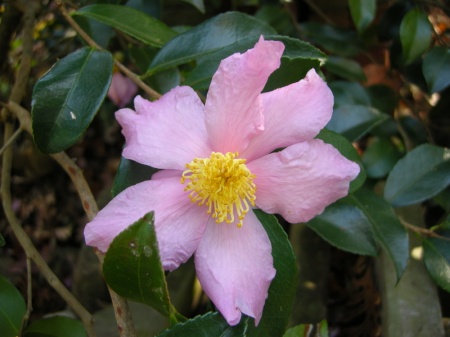 A close up of the lovely pale pink flower on the North Carolina State camellia pictured above.
A close up of the lovely pale pink flower on the North Carolina State camellia pictured above.
 Camellia x ‘Moon Festival’ has unusually large flowers with a crepe paper texture, but is hardy only to zone 7.
Camellia x ‘Moon Festival’ has unusually large flowers with a crepe paper texture, but is hardy only to zone 7.
 Charles and I both love this unnamed Ackerman hybrid pictured above and at the top of the post. We were thinking of potential names like “Winter’s Halo” or “Inner Glow”. Do you think it should be introduced?
Charles and I both love this unnamed Ackerman hybrid pictured above and at the top of the post. We were thinking of potential names like “Winter’s Halo” or “Inner Glow”. Do you think it should be introduced?
 Camellia x ‘Carolina Moonmist’ was developed by the J.C. Raulston Arboretum of NCSU with single pink flowers.
Camellia x ‘Carolina Moonmist’ was developed by the J.C. Raulston Arboretum of NCSU with single pink flowers.
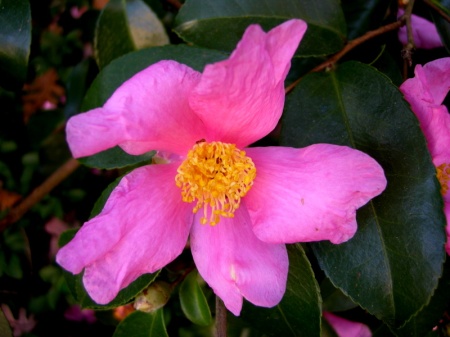 Camellia x ‘Carolina Moonmist’: Charles feels that this camellia is too late-blooming for our area because many of the buds won’t open before it is too cold. ‘Winter’s Star’ is a much better alternative.
Camellia x ‘Carolina Moonmist’: Charles feels that this camellia is too late-blooming for our area because many of the buds won’t open before it is too cold. ‘Winter’s Star’ is a much better alternative.
I tried to remain focused on camellias for the whole visit, but the garden is so beautiful that some other plants snuck in, and I have to share them:
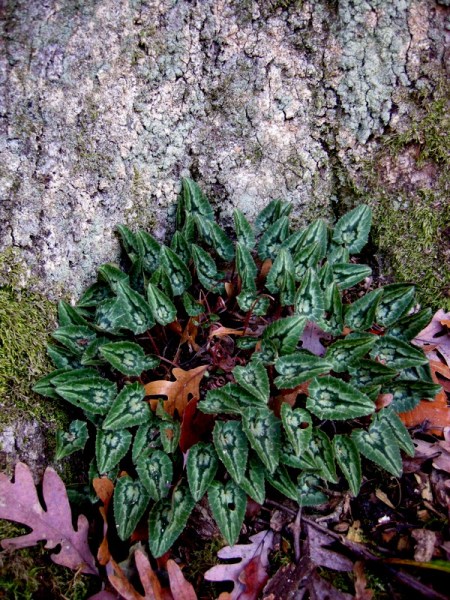 Fall-blooming hardy cyclamen seedling, C. hederifolium, growing at the base of a massive tree trunk.
Fall-blooming hardy cyclamen seedling, C. hederifolium, growing at the base of a massive tree trunk.
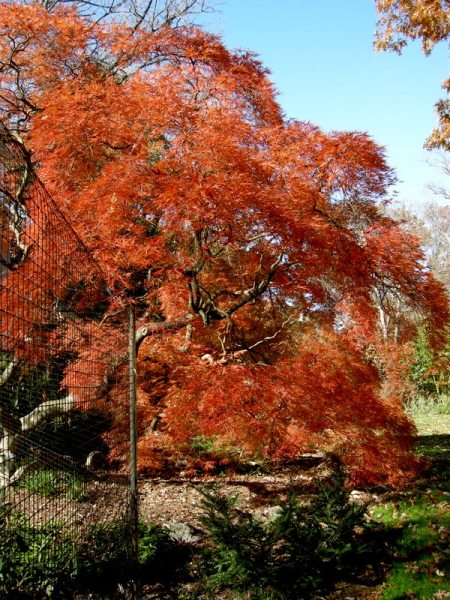 Japanese maple, Acer palmatum ‘Ornatum’
Japanese maple, Acer palmatum ‘Ornatum’
 The fall color of star magnolia, M. stellata.
The fall color of star magnolia, M. stellata.
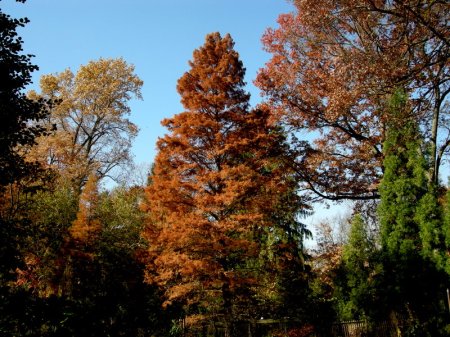 The fall color of bald cypress, Taxodium distichum.
The fall color of bald cypress, Taxodium distichum.
 We are so lucky in this part of the world to have such massive trees with gorgeous fall color.
We are so lucky in this part of the world to have such massive trees with gorgeous fall color.
Enjoy, Carolyn
Notes: Every word that appears in orange on my blog is a link that you can click for more information. If you want to return to my blog’s homepage to access the sidebar information (catalogues, previous articles, etc.) or to subscribe to my blog, just click here.

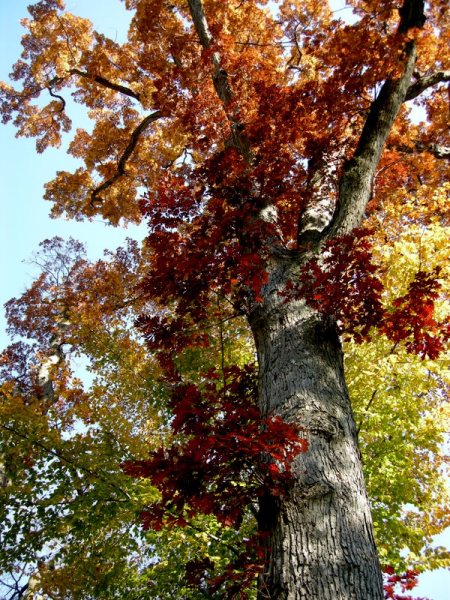
November 10, 2011 at 2:32 pm
Camillas and cyclemen are not hardy in my zone 5b garden. However, we grow these as ‘tropicals’ and grow outdoors in summer, but early October we bring them in as houseplants. Lovely even if they don’t overwinter. Thanks for the heads up on the new helebores coming soon too.
November 10, 2011 at 2:45 pm
Claudia, The camellias may not be reliably hardy in zones colder than 6A although I have had people in zone 5 tell me they grow them. Cyclamen hederifolium is reliably hardy in zone 5 and reportedly even in zone 4. It sounds like you are talking about the florist cyclamen that people grow as houseplants. Carolyn
November 10, 2011 at 2:47 pm
Just beautiful camellias. That Japanese maple and star magnolia take my breath away.
November 10, 2011 at 2:53 pm
Tina, It’s funny that even though camellias are so gorgeous and easy to grow, and they bloom at a time when you can really appreciate them, people don’t seem interested in buying them around here. I have offered them in my last two woody plant offers, and sales have been low. I am not sure what the stumbling block is. If anyone wants to comment on this, please do. Carolyn
November 10, 2011 at 10:55 pm
Carolyn, have you considered showcasing them in a container garden? They are very popular here in the PNW and I regularly use them for fall/winter designs.
November 11, 2011 at 8:35 am
Karen, All the hardy fall-blooming camellias in this post get quite large–6 feet would be a minimum–so I am not sure how suitable they would be for containers. I think there is one dwarf (3′ by 3′) that is hardy to zone 6 and would probably be great in a container. Do you bring the containers in for winter or can you leave them out in your zone? What zone are you? Carolyn
November 11, 2011 at 11:06 am
I suspect that many gardeners in our climate welcome a fall/winter respite from their gardens. They may simply prefer to find wonderful blooming shrubs that put on a show when they are more likely to be spending time outdoors.
Also, while I appreciate the beauty of the winter camellias in your photos, there’s something that looks incongruous about the lush and almost tropical look of the flowers with weather that has us bundled up and turning up our collars.
November 11, 2011 at 1:37 pm
Eric, You have made some good points. However, for me, fall is a whole gardening season in itself, and I am constantly outside cleaning up and mulching for next spring. It is still in the 50s and 60s through November. I have most of my camellias near my drive and front walk or on the way to the compost pile so that I will go by them all the time even if I am not outside. I guess the reason I prefer the fall-blooming camellias is because they are peaking when not so much is going on. The spring bloomers are lost in the general abundance of spring, which I really don’t need any more of. Rejoice in the incongruous nature of the flowers. Carolyn
November 10, 2011 at 2:57 pm
These are so lovely from their glossy deep green leaves to their beautiful blooms…I have decided not to try them with my winters, but I have many different cyclamen beneath my trees…what a beautiful place to visit!!
November 10, 2011 at 3:27 pm
Donna, If you had a very sheltered microclimate, you could probably grow them—are you zone 5? I am indeed privileged to be invited to Charles’s garden (many times I invite myself) on a regular basis. Carolyn
November 10, 2011 at 4:07 pm
Wonderful postings on Camellia’s. I just love them and I am so tempted to try one in my zone 5b. If I could find a sheltered area do you think it may survive?
November 10, 2011 at 4:12 pm
Lona, I have talked with gardeners who grow camellias successfully around Boston, and they are totally hardy in zone 6A. The winter sheltering in zone 6 is more so the winter sun doesn’t burn the leaves and extra cold weather doesn’t freeze the buds. Camellia Forest is a great mail order nursery for camellias if you need to mail order one. Carolyn
November 10, 2011 at 4:40 pm
I am also addicted to camellias, and thoroughly enjoyed seeing this post. The pictures are fabulous. Love that ‘Winter’s Glow’! (See, I made a new name from the two you provided.) I really do love its coloring. Love ‘Winter’s Snowman’, too.
November 10, 2011 at 5:55 pm
Holley, I love your enthusiasm. I will put ‘Winter’s Glow’ on the list. Have you posted about your camellias? I would love to know which you grow and what you think of them. Carolyn
November 10, 2011 at 7:40 pm
I have recently become obsessed with these things, as I am plotting a row of them in the parking garden. And I mean obsessed. I have never spent so much time picking out four plants in my life.
November 10, 2011 at 8:56 pm
Jess, My choices of camellias have been very random based on what I ran into at the time. There are so many wonderful cultivars to choose from that I don’t know what I would do if I had to make a reasoned choice. Ans where you are the hardiness issue isn’t a factor so you have even more choices. Carolyn
November 10, 2011 at 11:00 pm
You’ve been following my blog so I’m sure you also read my recent post about the new Monrovia introduction ‘Pink Yuletide’ . We have similar tastes!
I first fell in love with the spring blooming ‘Donation’ many years ago in England, but love these earlier ones even more. Winters snowman is a wonderful variety for smaller spaces.
November 11, 2011 at 8:56 am
Karen, People like you in warmer parts of the country are probably wondering what all the fuss is about—camellias have been around forever for you. But here in the mid-Atlantic we couldn’t grow camellias until Dr. Ackerman came along. Straight C. sasanqua, which is what ‘Pink Yuletide’ is, is not hardy here. Ackerman crossed C. sasanqua with C. oleifera to produce fall-blooming camellias that can survive in the mid-Atlantic and even the coastal areas of New England (with protection). For more information, read Dr. Ackerman’s article here. Carolyn
November 11, 2011 at 10:08 am
Yes camellias have always been a part of my gardens both here in Seattle and in the UK. There was also an incredible conservatory at Chatsworth House in Derbyshire filled with monster camellias – perhaps they were more tender?
America is such a HUGE country that I can’t wrap my head around all the different planting possibilities for each zone. Or at least I can’t remember them all, but it’s always interesting.
How wonderful that there are now choices for you too – many of which are popular here incidentally.
November 10, 2011 at 11:58 pm
Thank you Carolyn for continuing your tours of the camellia gardens! I think people haven’t recognized yet that camellias aren’t necessarily only for the deep South, but you are changing that with your blog. I am selecting my first two from among those Ackerman found especially cold tolerant,– Winter’s Waterlily and Ashton’s Supreme.
November 11, 2011 at 9:02 am
Rosemary, I guess it takes a long time to change perceptions. I find fall-blooming camellias to be the ideal shrub: beautiful dark evergreen shiny leaves and incredibly showy flowers during a time of the year when the garden is generally retreating. I would love to hear about your experiences with your camellias. ‘Winter’s Waterlily’ sounds especially intriguing if the flowers really are more frost tolerant. The problem with the fall-bloomers that bloom in December is that the flowers and buds generally get frozen. Charles Cresson prefers the cultivars that bloom in October and November for this reason. Carolyn
November 11, 2011 at 3:32 am
No wonder you are now an addict Carolyn, they are gorgeous, especially Winter’s Snowman., and yes, the unamed hybrid should be introduced to the public, it is beautiful.
Autumn flowering Camellias are fairly new over here in the UK, must go round my garden and see if I can squeeze one in somewhere.
November 11, 2011 at 9:04 am
Pauline, Readers have mentioned before that the fall-bloomers are unusual in the UK. I always think you are ahead of us in garden trends so I am amazed. You should definitely plant one but watch out because then you will want more. Carolyn
November 11, 2011 at 9:10 am
Wow! What beautiful camelias. Your photographs with the rock house and red maple remind me of the house my husband grew up in, in Phoenixville.
Jeanette
November 11, 2011 at 1:18 pm
Jeanette, Phoenixville is very near here, and it is beautiful this time of year. Thanks for stopping by. Carolyn
November 11, 2011 at 9:47 am
I’m not very good with camillias, they seem to get hit by frost & go brown before they ever have chance to bloom en-mass. Shame really x
November 11, 2011 at 1:30 pm
Jane, I guess it depends on your climate. Do you have early frosts in the UK? We have not had a hard enough frost to brown up the open camellia flowers although the annuals are gone. But even if we did, there are so many buds on each shrub that it hardly makes a difference. the remaijing buds continue to open for weeks. Carolyn
November 11, 2011 at 1:43 pm
There are several seedlings growing under my camellia, which seems too good to be true for such an exotic plant which finds itself in the UK. I didn’t notice it before and probably just weeded them out.
November 11, 2011 at 2:35 pm
Bag, Charles pointed out a lot of seedlings growing under his camellias during my tour. You should move your seedlings to a more hospitable spot–free camellias. My oldest camellia is a seedling from the original C. oleifera ‘Lu Shan Snow’ that was yanked from the ground and given to me during a tour of a local arboretum. I planted it and grew it on and now it’s 10′ tall with hundreds of flowers. Go for it! Carolyn
November 11, 2011 at 2:50 pm
Gorgeous camellias. Such a pretty flower and I always liked the glossy leaves as well. Unfortunately I live in too cold a zone now to have one of my own but thanks to garden blogs I can still appreciate the flowers in other peoples gardens.
November 11, 2011 at 4:18 pm
Marguerite, Fun to look at anyway like when I read Australian blogs. Carolyn
November 11, 2011 at 2:56 pm
How does a novice gardener tell a hardy cyclamen from the florist type? I bought 2 cyclamen tubers in the spring, planted them in pots (upside down I am embarrassed to admit) and months later leaves came up around the edge of each tuber. So now each pot has a circle of leaves (two-tone, dark green leaves that look similar to the one in your photo above). Out here on the edge of Philadelphia we’ve already had a frost or two so I’m reluctant to plant them outside if they are the tender type.
November 11, 2011 at 4:25 pm
Maryann, Chances are they are a florist’s cyclamen, C. persicum, but the leaves can be very similar. Where did you buy them and did they give the botanical name for them? Perhaps there is information on the seller’s website. Hardy (outdoor) cyclamen bulbs are generally sold as a dried bulb without leaves in the fall or as a growing plant with leaves in the spring. I have never bought a florist’s cyclamen except in a pot already covered with leaves and flowers. Feel free to give me more details and I will try to figure it out. Carolyn
November 11, 2011 at 4:26 pm
Love this post and all your others on camelias. I am wondering if the early blooming fall ones would be suitable for my garden in zone 6, putnam county, ny. I heard from Rarefind that fall blooming ones do better planted in the spring. Do you follow that rule?
November 11, 2011 at 4:57 pm
Terryk, I think they would definitely be suitable if you are in zone 6. I recommend protecting them from winter winds so they should face southeast rather than northwest. I also think that it couldn’t hurt to put them in a somewhat enclosed area if you have one. I plant mine in south or east facing corners or in front of walls. I just heard about spring preferred planting for the first time yesterday, but I think you should be fine if you plant early in the fall so the plant can get established. I wouldn’t plant one now (although I am just about to). All my camellias have been planted in the spring except two, and they are new this fall. I will keep track of how they do so I can report back. Thanks for asking all these great questions on the blog so others can read and benefit. Carolyn
November 11, 2011 at 5:30 pm
Carolyn, you asked about growing camellias in containers. I often use them – even if they’ll ultimately get 6′. I just enjoy them for as long as possible then transplant, trade or give away!
A 1 gallon pot does nicely in containers 14-18″ in diameter with room for a few little bits underneath. I often use 5g ones in larger pots 24″+. White blooming varieties look fabulous with white variegated Pieris japonica ‘Little heath’ underneath for example, Black mondo grass adds contrast. If there’s still room I use Heuchera ‘Peach flambe’ to echo the color of the new Pieris growth.
November 11, 2011 at 10:17 pm
Sounds lovely and good material for a post!!!
November 11, 2011 at 8:28 pm
My sasanquas just started blooming this week, and there are lots of buds yet to open. They make the impending winter bareable.
November 11, 2011 at 10:18 pm
Les, I am with you. I just gaze at them and admire their in-your-face attitude to the cold weather. Carolyn
November 12, 2011 at 11:32 am
Carolyn, I have never seen Autumn Camellias before, I think they are fantastic, I get a Rhododendron now and then with a flower or two in the month of November which always surprises me. The granite of the building behind the white Winter’s Snowman looks like it could have come from Aberdeen. The beautiful simplicity of the unnamed Ackerman hybrid deserves to be called Winters Halo.
November 12, 2011 at 11:40 am
Alistair, You will really have to try a fall-blooming camellia and report back. I will have more photos of them in my GBBD post. I will have to work on Charles to get “Winter’s Halo” introduced. Carolyn
November 16, 2011 at 9:08 pm
I enjoyed your reblooming irises – I have never been successful with them. But my heart really leaped with reading about the cold hardy camellias. Alas, they still don’t sound like they will survive in my Binghamton NY area garden (zone 5b) Sigh….
November 17, 2011 at 9:11 am
Alana, In zone 5B, I would still try an Ackerman hybrid camellia in a very protected area. Carolyn
July 20, 2012 at 2:55 pm
We spend part of the year in the hills (2,200′ elevation) of Western North Carolina (zone 7A) and are looking for camellias that bloom in August/September or May/June, when we are in residence. We know some kinds of camellias can grow here, the question is whether there are any that would bloom sometime during
the August/September or May/June time periods.
July 21, 2012 at 8:49 am
Bob, Sorry but I really can’t answer that question. All my camellias bloom before May and after September. I would ask for advice from someone in NC where you are located or a public garden down there like Duke Gardens or the JC Raulston Arboretum. Camellia Forest Nursery in Raleigh would be a great place to start. Carolyn